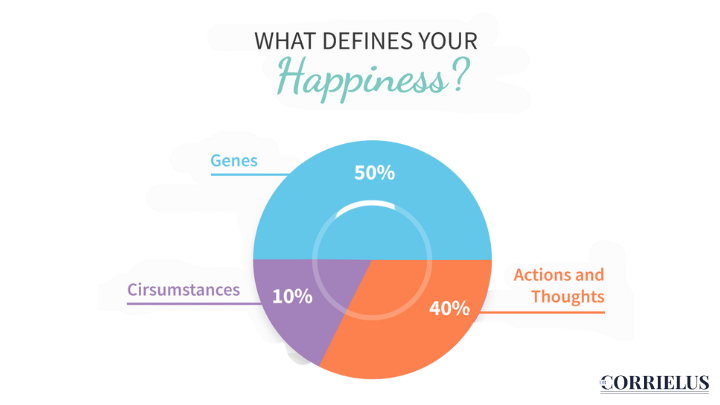Not only can happiness make us feel good, but it can also genuinely enhance our lives.
Positive feeling and well-being have been linked to a wide range of advantages, including increased professional performance, improved relationship functioning, increased creativity, improved physical health, and even longer life expectancy, according to a recent comprehensive meta-analysis.
The 50-40-10 rule
The researchers who created the first “happy pie chart” discuss what they have discovered over the previous 15 years.
Do you know the pie chart of happiness?
In the past 15 years, if you’ve read a book or attended a conference about happiness, there’s a high chance you’ve heard that genes account for 50% of our pleasure, activities account for 40%, and living circumstances account for 10%.
The pie chart, which was first put forth in a 2005 publication by researchers Sonja Lyubomirsky, Kennon M. Sheldon, and David Schkade, was neat and orderly and provided a clear picture of what factors affect our well-being. The chart indicated that unfortunately for some of us, the genes passed down from our parents have a significant impact on how fulfilled we feel. The good news is that we still have a lot of control over our happiness if we adopt healthy mental and physical habits.
What does the 50-40-10 happiness rule entail?
Sonja Lyubomirksy, a psychology professor and author of the book “The How of Happiness,” developed the 50-40-10 rule. This book mostly discusses the 50-40-10 rule.
The 50-40-10 happiness guideline goes as follows:
- Our genes determine 50% of our level of happiness.
- Our circumstances dictate 10% of our happiness.
- Our internal state of mind determines 40% of our level of enjoyment.
As it occurs, we can always influence 40% of our happiness, the book uses this “formula” to demonstrate how crucial it is to pursue happiness. The author refers to this as the “40 percent solution.” It implies that we always can affect our happiness by altering our perspective, regardless of the circumstances.
Also read: Can happiness break your heart?
Investigation on happiness today
Sheldon and Lyubomirsky indicate that they essentially accord with these concerns in their revised study on the pie chart.
Lyubomirsky argues that their initial study should have made clear how our genes, circumstances, and behaviors might influence and interact with one another. The numbers were intended to be estimations in a thought exercise, he adds.
“Our goal [more than 18 years ago] was more to ask: Is it feasible for happiness to increase and remain elevated?
—than to offer a solution,” claims Lyubomirsky. Our pie chart, like all pie charts, was greatly simplified.
In their article, Sheldon and Lyubomirsky state that “people can create for themselves a steady stream of engaging, gratifying, connected, and uplifting pleasant experiences, hence raising the possibility that they remain in the upper range of their happiness potentials.”
A word from the doctor
Ultimately, there is no way to predict how much happiness you’ll experience from any particular change you make.
No pie chart can tell us who we are as individuals. However, we can learn that trying is worth the effort.
If you need further information or medical help about your heart condition, contact me without any hesitation.
I ensure to incorporate heart-centered holistic techniques with traditional values and high standards of patient care.
Thus, schedule a consultation session today.



